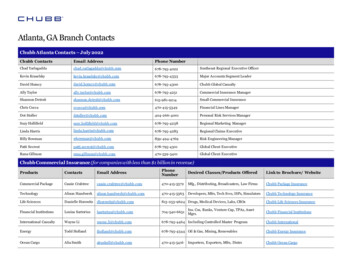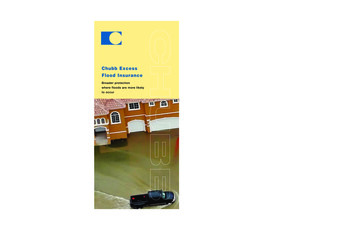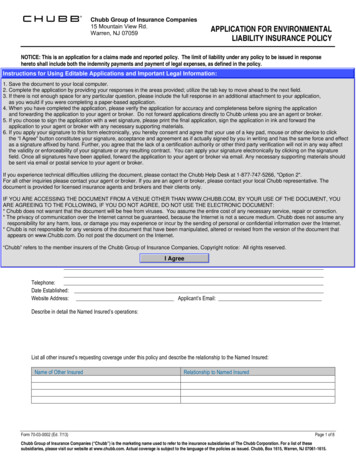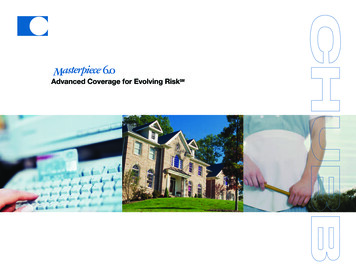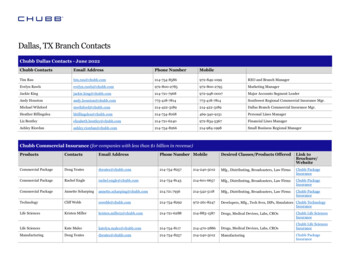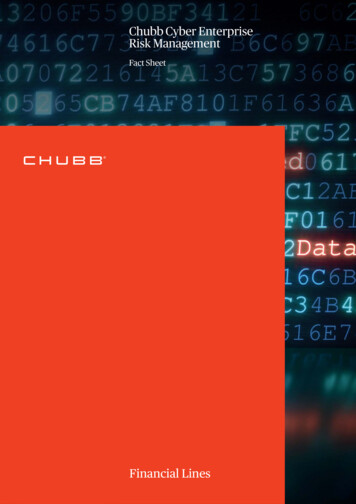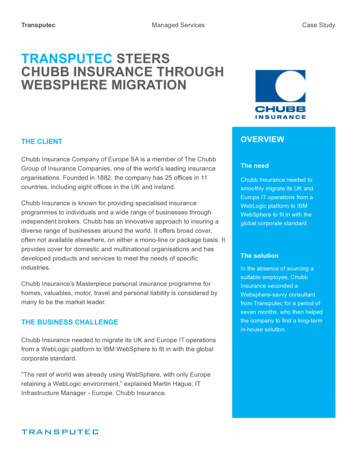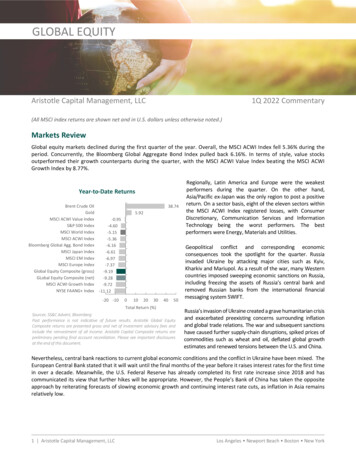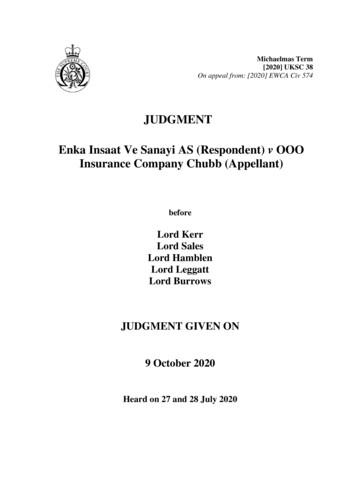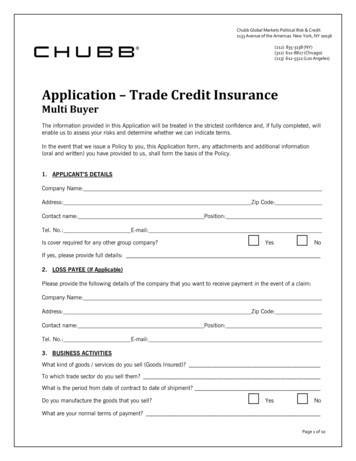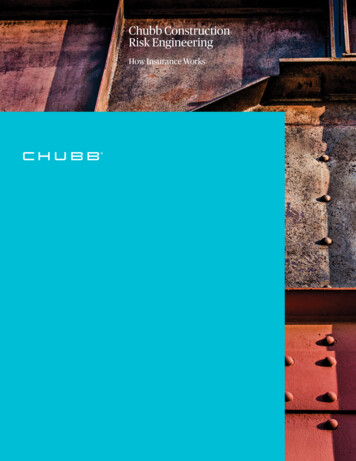
Transcription
Chubb ConstructionRisk EngineeringHow Insurance Works
Chubb Construction Risk EngineeringHow Insurance WorksWorkers’ Compensation InsuranceWhat is it?3Reasons for WC Insurance3Types of Disabilities4When does WC Not Apply?4Impact of Direct Costs on Insurance Rates and Premiums 42Understanding and Calculating EMR4Lowering EMR5Premium Calculation6General Liability Insurance6Overview6Taking Precautions7Other Liability Coverages7Automobile Liability Insurance7Cost Basis7Types of Coverage7
Chubb Construction Risk EngineeringWorkers’ Compensation InsuranceWhat is Workers’Compensation Insurance?Purchased by employers for theirworkers, Workers’ CompensationInsurance provides four types ofbenefits: medical care, death, disability,rehabilitation for employee job-relatedinjuries or diseases without regard tofault. Usually purchased by the employerfrom an insurance company, the cost (orpremium) is based on a percentage of theemployer’s payroll and depends on theemployee’s occupation.This insurance pays for income, medical,rehabilitation, death, and survivorpayments to workers injured on the job.State workers compensation laws requireemployers take responsibility for on-thejob injuries.Each state specifies the benefits foremployers in that state. Althoughthese benefits were designed to be theonly means to compensate employeesfor workplace injuries (known as“exclusive remedy”), workers havebeen allowed to sue employers for someon-the-job injuries in addition to workerscompensation benefits. Some statesmandate that employers buy workers’compensation insurance from a statefund, but some offer a choice of a statefund, self insurance, or commercialinsurance.While coverage differs widely betweenstates, provisions can be made for weeklypayments in lieu of wages, compensationfor economic loss, reimbursement orpayment of medical and like expenses,and benefits payable to the dependents ofworkers killed during employment.Reasons for Workers’Compensation InsuranceBefore Workers’ Compensation laws,injured workers had to sue employers,who had a number of strong defenses touse in avoiding a judgment. However, asuccessful suit could result in large andunpredictable costs for an employer.Workers’ Compensation Insuranceprovides for prompt payment of medical,rehabilitation, and lost time costs toState FundsCompetitiveExclusiveArizonaMontanaNorth DakotaCaliforniaNew MexicoOhioColoradoNew YorkPuerto RicoHawaiiOklahomaVirgin st VirginiaLouisianaRhode IslandWyomingMaineTexasMarylandUtahMinnesota3
Chubb Construction Risk EngineeringBefore statutory law, employees injuredon the job were only able to pursue theiremployer through civil or torts law.Proof of employer malice or negligencewas often required, but difficult for anemployee to obtain. Although employers’liability was unlimited, courts oftenawarded in favor of the employer, andpaid little attention to the full lossesexperienced by workers: medical costs,lost wages, and damages for loss of futureearning capacity.Types of Disabilities The injury occurred while theemployee was intoxicated; The employee injures him/herselfintentionally or while unlawfullyattempting to injure someone; The employee was injured by someonefor personal reasons, not for reasonsrelated to the employee’s employmentsituation; The employee was injured whilevoluntarily participating in an off-dutyrecreational, social, or athletic activitynot part of work-related duties, unlessTotal Disability BenefitPartial Disability BenefitMonthly income paymentfrom a Disability IncomeInsurance policy made to theinsured wage earner whenincome has been interruptedor terminated because ofillness, sickness, or accidentprovided the followingstipulations by the wageearner have been met:An amount usuallyexpressed as 50% of theMonthly Indemnity forthe Total Disability Benefitprovided by a DisabilityIncome Insurance Policy.1. Total disability for theduration that the policy isin force and beyond theElimination Period and2. While remaining totallydisabled, incomepayments are made atthe end of each monthuntil the limits on themaximum amount ofbenefit are reached, atwhich time paymentswill cease.4When Does Workers’ CompensationNot Apply?In general, Workers’ Compensationapplies to injuries arising “during andin the course of employment.” Whilerules vary by state, the insurance carriernormally is not liable to pay employeeincome benefits or medical benefits when:This amount becomespayable when the insuredwage earner’s incomehas been interrupted orterminated because ofillness, sickness, or accident.Residual DisabilityIncome InsuranceCoverage for an individualwith a residual disability.Benefits are usually payablefor the unused portion ofthe total disability benefitperiod up to age 65. If anindividual is at least age 55at the time of disablement,and total disability lastsless than a year, residualbenefits are payable forthe unused portion of thebenefit period for up to 18months, but not beyond age65. If there is at least a 25%loss in current earnings, theresidual benefits will equalthe percentage of loss timesthe monthly benefit fortotal disability. The residualdisability monthly benefitcan be expressed as:Loss of Monthly Income XMonthly Benefit for TotalPrior Monthly IncomeDisabilitythe activity was reasonably expected orrequired by the employment; The injury was caused by theemployee’s horseplay.Impact of Direct Costs on InsuranceConstruction and mining insurance costsaccount for over 5% of payroll, significantlyhigher than other industries. Theindustry’s share of workers’ compensationcosts is disproportionately high. In 2001,while construction workers were about 6%of the non-farm, private-sector labor force,the industry used 18% of employer costs ofworkers’ compensation.Percentage of Payrollinjured workers, while placing limits onthe cost of claims for employers.2.02%All Industries1.73%Services2.98%Goods Producing2.13%Manufacturing5.17%Construction, MiningUnderstanding the ExperienceModification Rate (EMR)EMR is an acronym for ExperienceModification Rate. EMR is a factor appliedto the premium of a policy which canprovide an incentive for loss prevention.The EMR represents either a credit ora debit applied to the premium beforediscounts. If your company’s lossexperience is higher than the average ofsimilar companies, the result is a debitEMR, or surcharge, on premiums.If your company’s experience is lesscostly than the industry average, youwill receive a credit EMR, or discount,on your premium.
Chubb Construction Risk EngineeringAn EMR of 1.0 is called a unity mod, anEMR below 1.0 is called a “credit mod,”and an EMR over 1.0 is a “debit mod.”Your EMR is based on claims costs overa three year period. An interval year isincorporated between that rating yearand the three year period. The yearprevious to the current year is excludedbecause claims have not yet been fullypaid, and premium has not been audited.Keep in mind that a contractor who hasdemonstrated a commitment to improvingits safety performance and has madestrides in enhancing the safety culture willnot necessarily see a marked improvementin their EMR because it is based primarilyon the losses for prior years. It can takea contractor two or more years to see areduction in the EMR resulting from safetyinitiatives introduced.How is the EMR Calculated?The EMR is determined by comparingactual losses to expected losses forthe experience period based on theemployer’s industry. In other words, ironworker employees are compared only toother iron workers.EMRType of EMR 1.0“unity mod” 1.0“credit mod” 1.0“debt mod” The number of man-hours worked isused to indicate the employer’s auditedpremium dollars, since an employer with200 employees would be expected tohave more claims than an employer with50 employees. For example, a RoofingContractor is compared only to otherRoofing Contractors with approximatelythe same gross premium amount. The formula adjusts the actual lossesused so that frequency is given greaterweight than severity of an injury orillness. For example, six claims thatoccur over a three year period totaling 20,000 have a greater impact againstthe EMR than one claim in three yearstotaling 20,000. Claims with zero costs are not includedin the EMR calculationHow can you lower your EMR?A sound safety program, a return to workprogram, and effective loss preventionprocedures will lower your EMR. Thefollowing example compares two SteelErection Contractors who perform thesame type of work and employ the samenumber of workers.XYZ Steel Erectors This contractor has a strong safetyprogram, good claims history and alow EMR. They have an EMR of .85, giving them a15 percent discount on their Workers’Compensation Premium compared toother companies in the same industry,Claims Costs for 3 – Year PeriodInterval YearRating Year01/01/200101/01/200401/01/200501/01/2005 EMRis calculated01/01/2005 EMRis calculated01/01/200201/01/2003 Because XYZ has a credit EMR, theyonly pay .85 for every dollar ofcoverage receivedABC Steel Erectors This contractor has an inadequatesafety program, bad claims historyand a high EMR. They have an EMR of 1.25. ABCpays .25 more for their Workers’Compensation insurance compared toother companies in the same industry. For every dollar of insurance coveragereceived, ABC will pay 1.25. That is .40 more for every dollar of coveragethan XYZ pays.Workers’ Compensation ManualRates by Class CodeBelow is an example of the different ratesyou can expect to pay for different typesof labor when working in various states.How is the Premium Calculated?Premium is calculated by multiplying thepayroll by the manual rate. This number isthen multiplied by the EMR ([Payroll/100]X manual rate X EMR Premium).Using the example above let’s look atwhat the total cost of insurance will be forthese two contractors:XYZ Steel ErectorsThis contractor is an Indiana basedContractor that has an annual payroll of 10,000,000 per year, a manual rate of22.08 and a .85 EMR.5
Chubb Construction Risk EngineeringBased on the formula above XYZ Erectorswill pay 18,768.[ 10,000,000/100] X 22.08 X .85 1,876,800.ABC Steel ErectorsThis contractor is an Indiana basedContractor that has an annual payroll of 10,000,000 per year, a manual rate of22.08 and a 1.25 EMR.Based on the formula above XYZ Erectorswill pay 27,600.[ 10,000,000/100] X 22.08 X 1.25 2,760,000.As you can see, XYZ Erectors will be muchmore competitive than ABC Erectorsbecause they are paying less for insurance– a difference of 883,200.crane operator would pay for the injuriesand lost wages.Property Damage (PD)An employee backs up a front-end loader,and crunches someone’s vehicle. The GLpolicy would pay for the car repair andrental replacement while in the shop.Most insurance companies requirepolicyholders to promptly report anyaccidents that could lead to a liabilityclaim. The insurer may then requirethe business owner to document thesituation, forward all related summonsTo cover these types of situations, manycompanies purchase “umbrella liability”insurance, which picks up where theirgeneral liability coverage ends. Umbrellaliability covers payments that exceedyour other policy’s limits and providesadditional coverage for liabilitiesnot covered in a standard liabilityinsurance policy.Taking PrecautionsTaking precautions before an accidentcan help keep your liability and insurancerates down. All businesses can takecertain steps to minimize the likelihoodof a liability insurance claim: Set a high standard for productquality control; Make sure all company records arecomplete and current;TradeAlabamaCaliforniaIndianaMinnesotaNew .3924.19Steel Erection49.7427.7922.08125.0450.5514.97General Liability OverviewOverviewA general liability insurance policy paysfor the legal costs of a Contractor in acovered liability claim or lawsuit. Coveredliability claims include bodily injury,property damage, personal injury andadvertising injury (damage from slanderor false advertising).It also covers compensatory and generaldamages. Punitive damages aren’tcovered under general liability insurancepolicies because they are consideredpunishment for intentional acts6Bodily Injury (BI)A crane operator accidentally dropspart of a load, which injures anothersubcontractor’s employee on the site.The general liability (GL) policy of theand legal notices, and cooperate fully inany investigations.General liability insurance policies alwaysstate a maximum amount that the insurerwill pay during the policy period, called a“Limit of Liability.” Usually these policiesalso list the maximum amount the insurerwill pay for a single occurrence. Forexample, if a contractor has a 1 millionoccurrence cap in their liability policyand they are successfully sued for 1.5million, the insurer would pay 1 millionand the contractor would be responsiblefor paying 500,000. Be sure employees are properlytrained; Obtain a safety review andrecommendations for your operationsfrom your insurance company; Protect the public from hazards onyour site.Other Liability Coverages(See following page)
Chubb Construction Risk EngineeringPublic LiabilityCoverage for a contractor’sliability for injuries or propertydamage suffered by thirdparties due to the contractor’songoing operations.Examples: On a street/road project, a motorist strikes a pothole, loses control and hasan accident; Inadequate overhead protection for sidewalk results in debris falling on pedestriansresulting in injury; An attractive nuisance, a huge pile of dirt, brings in a group of curious children oneof which falls and becomes injured.CompletedOperationsCoverage for a contractor’sliability for injuries or propertydamage suffered by thirdparties due to the contractorcompleting an operation. Thecontractor must take reasonablecare in rendering a project safeand free from hazards.Example: A paving contractor resurfaces a rural highway according to specs providedby the DOT. Three years later, in a heavy rain, two vehicles have a head-on collision.The widows sue the contractor, alleging that the slick surface caused the accident.The GL policy would defend the lawsuit, and pay if the contractor was deemednegligent by a judge or jury.ContractualLiabilityLiability incurred by a partythrough entering into awritten contract.Example: A plumbing contractor solders a joint, and leaves before it has cooled.The building burns down, and the owner sues the plumber and the general contractorfor negligence. The GC tenders its suit to the plumber, based on their contract whichincludes a “Hold Harmless” clause for liability arising out of the plumber’s work.The plumber’s GL policy would cover the GC under the contractual liability provision.Automobile Liability InsuranceCost BasisThe cost of automobile coverage is basedon the frequency and cost of potentialaccidents, theft and other losses.Premiums also vary depending onthe amount and type of coverage, thetypes of vehicles, driver’s motor vehiclerecords, years of driving experience,and the number of miles the vehicle isdriven per year. Other factors taken intoaccount include drivers’ age, where thevehicle is most likely to be driven and thetimes of day (e.g. rush hour in an urbanneighborhood or leisure-time drivingin rural areas). Credit history-relatedinformation may also be used.injuries to the driver and passengers ofthe policyholder’s car.3. Property damage liability, for damagethe policyholder causes to someoneelse’s property.4. Collision, for damage to thepolicyholder’s car from a collision.5. Comprehensive, for damage to thepolicyholder’s car not involving acollision with another car (includingdamage from fire, explosions,earthquakes, floods, and riots),and theft.6. Uninsured motorist’s coverage,for costs resulting from an accidentinvolving a hit-andrun driver or a driverwho does not have insurance.Types of CoverageThere are basically six different types ofcoverage. Some may be required by lawwhile others are optional, such as:Example:A driver hauling a trailer with anexcavator changes lanes on a freeway.Unfortunately, he doesn’t see the Ferrariin his blind spot, and forces it off the roadinto a bridge abutment.1. Bodily injury liability, for injuries thepolicyholder causes to someone else.2. Medical payments or Personal InjuryProtection (PIP) for treatment of Bodily Injury (BI): Pays the medicalbills, lost wages, and any rehabincurred by the Ferrari driver. Property Damage (PD): Pays to repairthe Ferrari, rental car while it’s in theshop, and repairs to the bridge. Collision: Pays to repair the truckand trailer of the driver who causedthe accident.Key Point Review Whether Workers’ Compensationapplies can be a challenge to determine. Through the EMR, your safety recordhas a significant impact on the costof insurance. There are ways of lowering your EMR,which then lowers insurance ratesand premiums. General liability coverage includesnot only public liability, but alsocompleted operations, products,and contractual liabilities.7
Chubb is the marketing name used to refer to subsidiaries of Chubb Limited, providing insurance and related services.For a list of these subsidiaries, please visit our website, www.chubb.com. Insurance is provided by ACE AmericanInsurance Company and its U.S. based Chubb underwriting company affiliates. All products may not be available in allstates. This communication contains product summaries only. Coverage is subject to the language of the policies asactually issued. Surplus lines insurance is sold only through licensed surplus lines producers. Loss control evaluations,reports, recommendations and services are made solely to assist the insurer in underwriting and loss control and arenot to be construed as an added benefit for the insured, property owner or any other party (this may not apply if losscontrol services are purchased separately and specifically pursuant to a service agreement). Evaluation for any hazardor condition does not imply that it is covered under any policy. Chubb is the world’s largest publicly traded propertyand casualty insurance group. With operations in 54 countries, Chubb provides commercial and personal property andcasualty insurance, personal accident and supplemental health insurance, reinsurance and life insurance to a diversegroup of clients. Chubb Limited, the parent company of Chubb, is listed on the New York Stock Exchange (NYSE: CB) andis a component of the S&P 500 index.Copyright 2016 (Rev. 6/16)
An EMR of 1.0 is called a unity mod, an EMR below 1.0 is called a "credit mod," and an EMR over 1.0 is a "debit mod." Your EMR is based on claims costs over a three year period. An interval year is incorporated between that rating year and the three year period. The year previous to the current year is excluded
